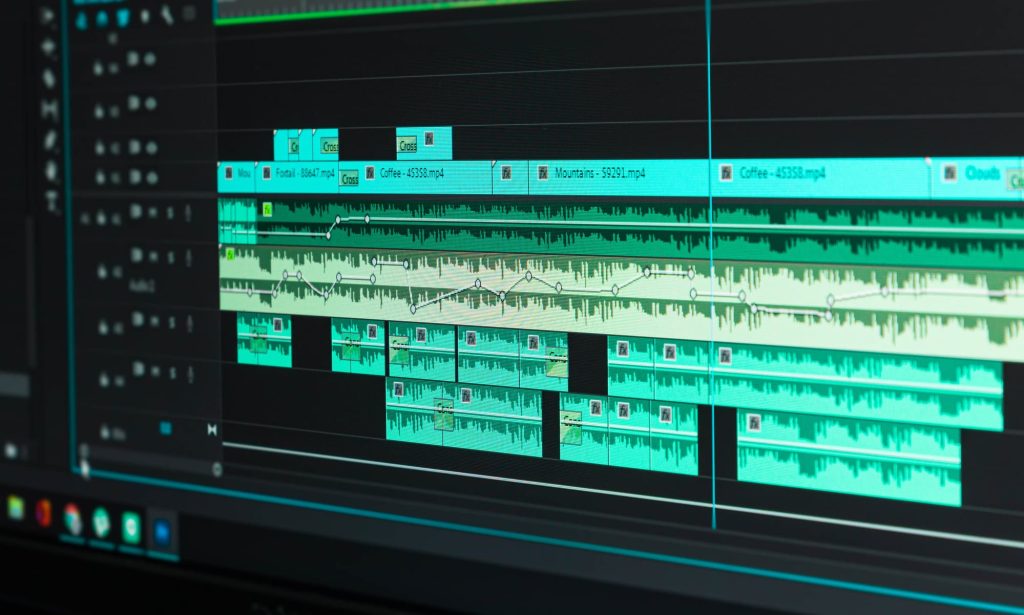When you need video editing work done, you may find yourself confused by the terminology. You’re adjusting the video’s length, but is it considered a trim or cut? What if you need to combine two clips to create a video that’s longer than the original? Aren’t trimming and cutting the same thing? The questions start to pile up.
No need to worry. We’re here to help.
When you want to hire someone to edit your videos, making sure you and your team understand the basics of video editing so that you can request the right things is essential.
To get an understanding of trimming and cutting video, let’s break down what those terms mean and how you do each action, along with some other useful definitions.
Understanding Trimming & Cutting Video

Think about recording a video on your phone and wanting to put it up on social media. Maybe there is superfluous content at the beginning and end, some extra sections of you hitting start and stop on the recorder. You use a video editing app on your phone or within the social media app to trim off those few seconds. Basically, you’ve done some video editing using trimming.
Now, imagine the same situation, except this time there’s a section in the middle where you laugh or mess up, and you need to remove those moments from the recording. In that instance, you’ll be cutting the video footage.
When you’re looking at the professional definition of these two terms, you can expect the same type of actions. Let’s take a look.
Trimming

By trimming, video editors are usually talking about the process of “trimming off” either as part of the beginning or the end of a video file. This process is done to reduce its total length or leave only the desired content and remove unnecessary sections.
Trimming is essential if you want to make sure your video doesn’t have a delayed start, boring viewers who won’t wait for something interesting to happen. After all, the first few moments of your video are what draw in viewers, snag their attention, and convince them to keep watching the rest of the video.
It’s also essential to trim away excess at the end that might poorly affect your length or look unprofessional. When applied correctly, video trimming helps you take away all the unnecessary bits from the end or the beginning, leaving only the content that you want your viewers to see and that which they’re most likely to enjoy.
Trimming can seem easy to apply, but often you need a skilled set of hands and eyes and the right software. That’s where a video editor will be able to help you. Now, let’s cover cutting.
Cutting
Cutting is another essential part of video editing. It is usually understood as the process of getting rid of a section or sections of your video by cutting in two places and taking out the middle section. Then, the editor puts the remaining halves of the video back together.

When you need to take out some meaningless or unhelpful sections, stumbles, or extra clips, cutting is also very useful. Cutting is also a particularly useful technique when you want to insert a section of a video clip into another one. When you have to cut a video into several pieces because of video length limits, such as on social media, cutting is also very useful.
It’s very common to confuse cutting and trimming. After all, they both have to do with deleting or taking out some parts from a video. However, when you trim a video clip, the idea is you’re sticking with the beginning and /or end of the clip. With cutting, you’re removing a piece of the video from somewhere else, typically in the middle somewhere. When you’re requesting edits on your video, understanding this difference is important. You want to be sure you’re asking for the right edit.
Let’s cover two other types of editing that you may also be confusing with trimming and adjusting the length- splitting and splicing.
Splitting & Splicing

If you have a very long section of footage, and you’re looking to cut it into sections that you’ll work with separately and use to create separate videos, then what you’re talking about is splitting the video.
When you want to join two video clips together to create one new whole, you are talking about splicing them. Both of these techniques affect the overall length of a video, but it’s important to remember that splitting isn’t trimming. And splicing isn’t splitting.
Is Video Editing Really That Important?

After learning about these two basic techniques and the two others that are related to them, you’re probably wondering, “Is it really necessary to do all this editing to a video?”
Before answering that important question, let’s talk a little about why videos are important in the first place because that consideration will direct us toward the answer.
You may have read other articles that show the statistics surrounding how effective videos can be in piquing people’s interest, garnering brand awareness, and selling a product or service. Here are a few of those types of results you can expect from your video content:
- People can learn or retain a new concept much better through video. In fact, they do it 70% better when taught or informed in video format.
- Conversion rates on video are also better. Brands and businesses can increase their conversion rate to roughly 10% for a novel product when it’s showcased through video, as reported by Dropbox in 2009.
- The likelihood to return also goes up. You can potentially improve your visitors’ likelihood of returning to your website by roughly 37% when using accompanying videos.
So, as you can likely see or perhaps already know, video content is powerful. It’s growing in popularity, and it can do so much for your business. One of the extremely important parts of using video in your marketing and promotion is showing your viewers high-quality videos, not only because it’s more professional but because it’s also what people have come to expect.
What is the key to getting highly engaging and top-notch video content? The answer is professional editing. By working with a professional editing service or subscription, you can ensure that each video you release looks polished and clean. And the editors do it all through trimming, cutting, stitching, and other techniques.
Your videos can create an impact, evoke the right emotions, and create a connection with your target audience, and you can do it best through editing. That’s why understanding and using editing techniques is so important.
How To Get Video Trimming and Length Adjustment
Not all brands have a professional video editor on hand to create and edit the perfect video to represent their products, services, or brands. Hiring in-house can be expensive and time-consuming. Finding someone who’ll work for you that won’t cost an arm and a leg can also sacrifice quality.

If you’re in need of high-quality video editing, including trimming and dusting length, as well as graphic design, video, and more, a flat-rate creative services subscription will provide you with all the necessary assets for a flat monthly fee.
The most useful of these types of subscriptions is the all-in-one option you’ll get with Flocksy.
Getting Your Perfect Video with Flocksy

With Flocksy video creation and editing services, you can start a trimming or adjusting length project right from the easy-to-use dashboard and see fantastic results in no time.
Getting started is simple. All you need to do is open up the “Create new project” option and choose a video project. From there, select “trimming” as the subcategory if you’re looking to get rid of clips at the beginning or end. If you’re cutting out other sections, you’ll want to choose the “adjusting length” subcategory. From there, you can use what we talked about above to describe what you’d like to see from your dedicated team of editors.
You’ll also want to let them know what your goal is for the video, what you’ll be using it for, and provide any references of videos you’ve seen and enjoyed that you’re trying to emulate. It’s possible your video editor will suggest other edits to make the video really shine.
Soon, you’ll have your perfected, professional video edited by someone who can capture your vision with the highest quality and speed.
